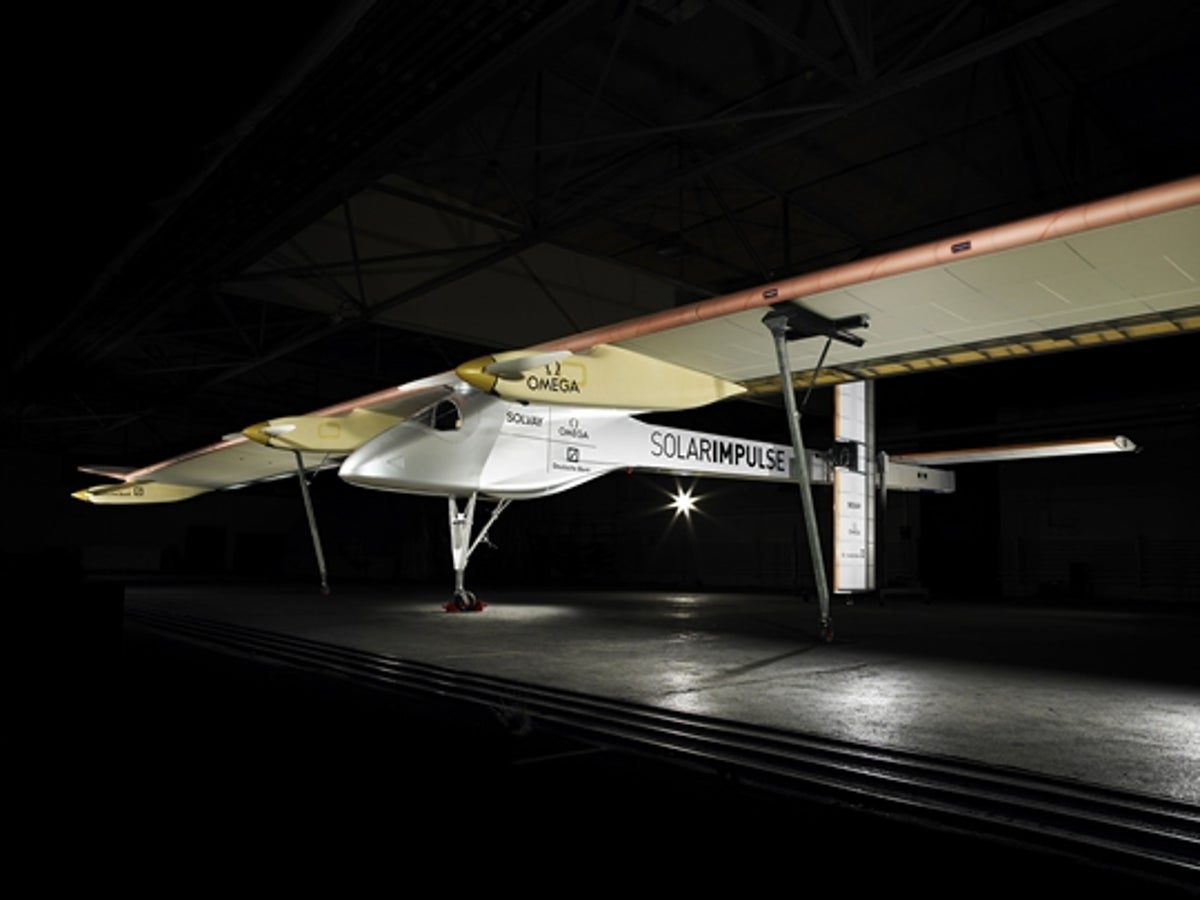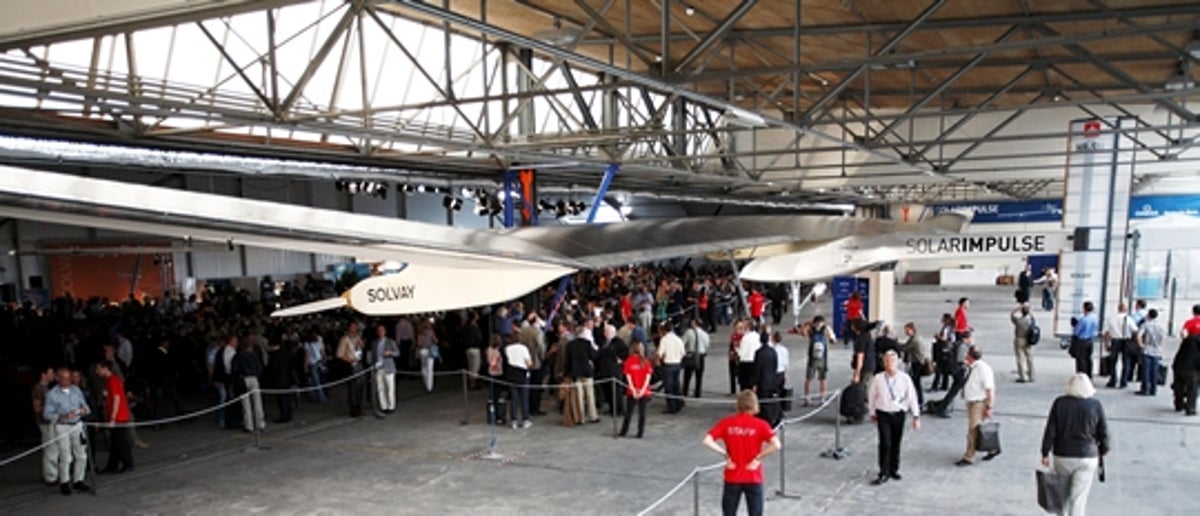Photos: Soaring ambition for solar aircraft
The Solar Impulse HB-SIA is designed to fly both day and night without the need for fuel and without producing any pollution.

Solar Impulse HB-SIA
The Solar Impulse HB-SIA is designed to fly both day and night without the need for fuel and without producing any pollution. The plane, which is scheduled to make its first flight later this year, was built to stay airborne for several days operating just on the power emitted by the sun and captured by its solar panels. The goal and challenge of the craft is to show the viability of renewable energy.
"If an aircraft is able to fly day and night without fuel, propelled solely by solar energy," says Piccard, "let no one come and claim that is impossible to do the same thing for motor vehicles, heating and air conditioning systems, and computers."
Caption by Lance Whitney
Wingspan
The long wingspan, like that of a glider, boosts the plane's aerodynamic efficiency by decreasing drag, thereby lessening the power required by the electric motors to keep the HB-SIA in the air. This reduces the craft's sink rate, the speed at which it descends to the ground, to guard against too hard a landing.
Under the wing are four small pods, each containing a motor, a polymer lithium battery, and a system to regulate the charge and discharge of each battery. Thermal insulation helps conserve the heat generated by the batteries and keeps them running at an optimal temperature, according to Solar Impulse.
An on-board computer will constantly analyze the flight parameters, providing the pilot with the information needed to make key decisions. The computer will also send data to the ground team and regulate power to the electric motors. Through this technical chain of events, the HB-SIA will automatically handle course corrections and conserve the amount of energy consumed.
Caption by Lance Whitney
Solar panels
When the Solar Impulse HB-SIA begins its first lengthy test flight throughout the day and night, the pilots must hope the batteries have enough energy to keep it in the air until the sun comes up the next morning to recharge the panels.
Caption by Lance Whitney
Carbon fiber skeleton
Caption by Lance Whitney
HB-SIA specs
• Wingspan: 63.40 meters (208 feet)
• Length: 21.85 meters (81 feet)
• Height: 6.4 meters (20 feet)
• Weight: 1,600 kilograms (3,527 pounds, or 1.6 tons)
• Motor power: 4 x 10 HP electric engines
• Solar cells: 11,628 (10,748 on the wing, 880 on the horizontal stabilizer)
• Average flying speed: 70 kilometers per hour (43 miles per hour)
• Take-off speed: 35 kilometers per hour (21 miles per hour)
• Maximum altitude: 8,500 meters (27,900 feet)
Caption by Lance Whitney
Virtual flight
Five screens set up around the cockpit gave the pilot the feel of a real flight.
"I went into a simulator and came back out of an airplane," said Piccard after the 25-hour simulation. "This proves to what extent the simulation is fascinating."
Caption by Lance Whitney
Bertrand Piccard
Using the money he won for his historic Orbiter flight, Piccard started the humanitarian foundation Winds of Hope, which tries to combat deadly childhood diseases in poor countries.
Caption by Lance Whitney
Piccard family
Grandfather Auguste Piccard devised the principles behind both the stratospheric balloon and the pressurized cabin. Flying a pressurized, hydrogen-filled balloon into the stratosphere, he reached an altitude of 15,780 meters, or 51,771 feet, in 1931 and 16,201 meters, or 53,152 feet, in 1932. Using the same concept of pressurization, he later invented a submarine called the Bathyscaphe Trieste, and in 1953, dove beneath the sea with his son Jacques to a depth of 3,150 meters, or 10,334 feet.
Jacques Piccard followed in the family footsteps by developing underwater vehicles to study the ocean depths. Traveling in the Bathyscaphe Trieste, he and co-pilot Lt. Don Walsh are still the only two people to have reached the deepest point underwater, diving to a distance of 10,916 meters, or 35,813 feet, in 1960. He later explored the Gulf Stream with another submersible vessel that he invented. Piloting the mesoscaphe Ben Franklin, he and his crew stayed underwater for a month, providing a test study for the effects of such a lengthy journey on human beings. NASA has long incorporated research from this mission in planning its space flights.
Caption by Lance Whitney
Andre Borschberg
As a mechanical engineer and MIT graduate in management science, Borschberg has also started and managed several companies, including a risk capital venture and two technology firms. Like Piccard, he's devoted himself to social causes and has worked on behalf of Restos du Coeur (Restaurants of the Heart), a French charitable group that distributes food to the poor and homeless.
Caption by Lance Whitney
Solar Impulse team
To build the prototype, a subteam of 50 specialists, aided by close to 100 external advisers, combined their knowledge and expertise. The plane had to be constructed to satisfy the needs of the designers, equipment suppliers, and pilots. Extensive research and testing were done in such areas as aerodynamics, energy efficiency, mechanical structure, and manufacturing processes.
Here the entire Solar Impulse team lines up at the Dubendorf construction facility in which the Solar Impulse was assembled.
Caption by Lance Whitney

News conference
Caption by Lance Whitney
Artist's impression
The aircraft will then take its first night test flight in 2010 to see if it can stay in the air for a 36-hour day-night-day cycle running solely on battery power without any fuel. From there, the next generation of the Solar Impulse, the HB-SIB, will make two test flights in 2012--the first across the Atlantic, and the second around the world in five legs over the course of four to six days.
Here, an artist renders his impression of what the Solar Impulse might look like once it takes to the skies.
Caption by Lance Whitney